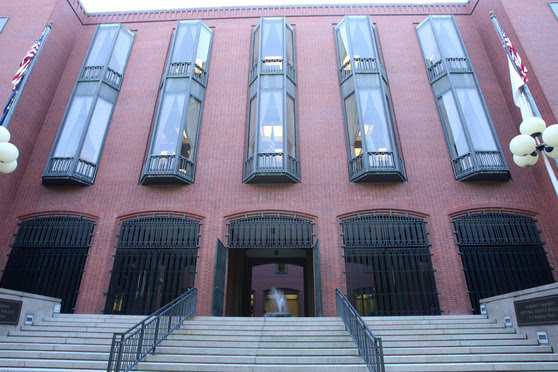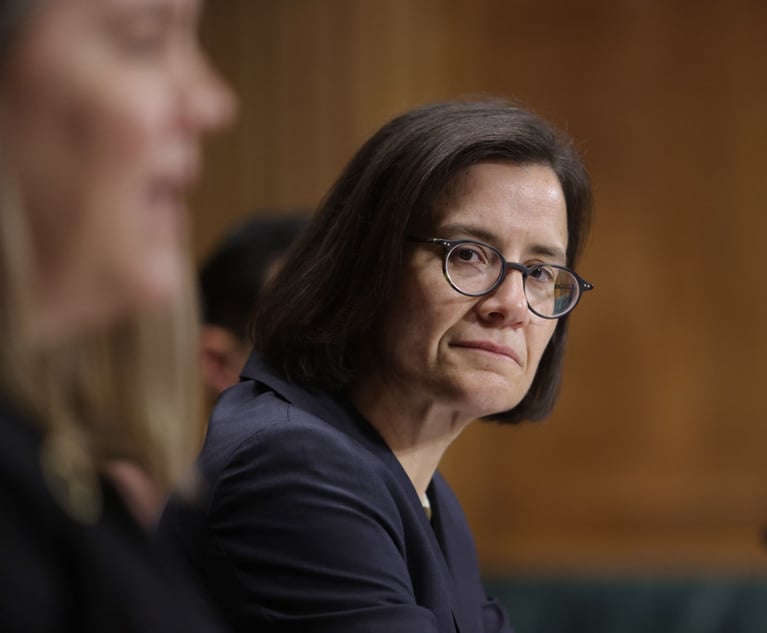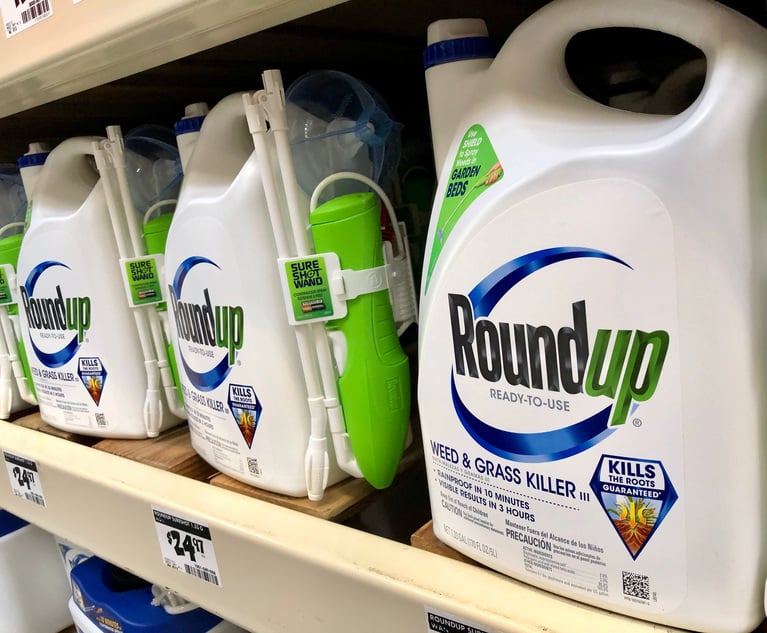Skilled in the Art: What the Federal Circuit Is Saying About PTAB Shake-Up
The judges are trying to figure out how to handle appeals of PTAB decisions where the board instituted proceedings on a subset of inter partes review claims, instead of all of them as required by recent Supreme Court guidance.
May 04, 2018 at 03:30 PM
8 minute read
Welcome to Skilled in the Art. I'm Law.com IP reporter Scott Graham, and on Tuesday I promised to take a break from the Supreme Court's SAS Institute decision. I lied! Given the multiple times it's popped up during this week's Federal Circuit arguments, I can't ignore it. But I've got plenty of other IP-related news and commentary below. In the meantime, email me your thoughts and feedback and follow me on Twitter.
➤➤ Would you like to receive Skilled in the Art as an email? Sign up here.
Federal Circuit: What to Do With These SAS Issues?
The Patent Trial and Appeal Board issued guidance last week on SAS Institute v. Iancu, the Supreme Court decision that requires the board to review all challenged claims in an inter partes review petition if it chooses to review any. The knottiest question was how to handle cases where the board already instituted proceedings on a subset of claims.
The Federal Circuit is in the same boat. There are numerous appeals of PTAB decisions pending before the appellate court where the board only reviewed a subset of challenged claims. The judges began thinking out loud about their own guidance in at least four cases argued this week. Here were some of the issues:
➤ Does SAS require the board to review each challenged claim, or every single ground of unpatentability raised within each challenged claim?
Yeda Research and Development v. Mylan is part of a big patent brawl over the multiple sclerosis drug Copaxone. The PTAB invalidated all 20 challenged patent claims—but on only one of three asserted grounds. Will the Federal Circuit have to send it back to the PTAB?
“I thought the Supreme Court was reasonably clear that both grounds and claims were encompassed within the scope of their decision,” Judge William Bryson told Goodwin Proctor partner William Jay. ”Is that not so?”
“I don't have a firm position on that,” Jay said.
“Well, but does the Supreme Court have a firm position on that?” Bryson said to laughter in the courtroom. “I had the impression they did.”
Jay clarified his client hasn't taken a position because there'd be no practical impact on the case. But, he argued, the language Justice Neil Gorsuch used in his opinion, the provision of the America Invents Act Gorsuch relied on, and the question presented by SAS's cert petition all point to claims, not grounds.
Jay's opponent, David Anstaett of Perkins Coie, agreed there's no need for remand. “I do think we have a fundamental agreement that this is not the case in which to address SAS,” he told the court.
➤ But does it matter what the parties want?
Just as in Yeda, the parties in PGS Geophysical v. Iancu sounded ready to move on with their patent lives, even if some unfinished business was left behind at the PTAB. In fact, the petitioner in the case has already settled out, leaving only the PTAB to defend its judgment. But Judge Richard Taranto didn't sound quite ready to sign off.
The question is “whether we have a final written decision in front of us that we can exercise jurisdiction over,” Taranto said. By way of analogy, if a trial court hasn't adjudicated all of the claims in a district court judgment, “we wouldn't have jurisdiction” on appeal, he pointed out.
Williams & Connolly partner David Berl, who represents patent owner PGS Geophysical, said he does not believe SAS announced a jurisdictional rule. Sometimes patent claims are amended during IPR or settled, and therefore aren't part of the final written decision. “There is a final decision in this case,” he said, “and it is a final decision on all claims that are presently in dispute between the parties.”
Judge Evan Wallach raised a practical concern. “If we did send it back down, who would represent whom with what positions?” he said.
Berl said that would lead to “sort of a kabuki theater” where the PTO plays the petitioner's role. “They'd then be judge, jury and executioner in the same case,” he said.
“They've met the enemy and he is us,” Wallach joked.
Taranto said the court may ask for further briefing on the issue.
➤Assuming the Federal Circuit does have jurisdiction, what do litigants have to do to preserve an SAS issue on appeal?
In Jazz Pharmaceutical v. Par Pharmaceutical, Quinn Emanuel Urquhart & Sullivan partner Kathleen Sullivan argued that petitioner Amneal Pharmaceutical waived any right to further PTAB adjudication by failing to move for reconsideration and by failing to file a cross-appeal. “They did not include in their red brief a paragraph as to SAS, the way we included in our blue brief a paragraph as to Oil States,” she told the court.
“We're gathering information, so I don't mean to be facetious by this question,” Judge Jimmie Reyna said. “But if you were on the other side, would your argument be the same?”
“Your honor, if I were on the other side I would say SAS gives us a do-over,” Sullivan replied. “But on my side I have to say I'm sorry, it's too late. You didn't ask for anything that would have preserved your right to a do-over.”
Amneal, which knocked out some 70 of 95 challenged claims on six patents related to the narcolepsy medication Xyrem, is not requesting a do-over. “It seems to us that we've come this far on the claims that [were] instituted,” Maddox Edwards' Steven Maddox told the court. “You should rule on those—those are properly before you.”
➤ Just how complicated is all of this going to be?
In Assa Abloy v. Spectrum Brands, Fish & Richardson partner Michael McKeon predicted there will be “a lot of interesting discussion” generated by SAS ”over the coming months and years perhaps.”
That may be, but it doesn't affect the Assa Abloy appeal, Knobbe Martens partner Michelle Armond argued. “SAS has the simple holding that all of the claims that are challenged in the petition must be considered by the board,” Armond began, before Judge Kimberly Moore interjected.
“I'm not convinced the holding of SAS is anywhere near as simple,” Moore said. “But I'm also not sure it's relevant to this case.”
“I never, ever thought I'd be a lawyer.”
— Former PTO Director Michelle Lee, recounting her journey from Silicon Valley kid to head of the USPTO on Richard Hsu's Hsu Untied podcast.
Introducing Kwun Bhansali Lazarus
San Francisco has minted another IP-centric boutique. Keker, Van Nest & Peters litigators Michael Kwun, Asim Bhansali and Kate Lazarus launched Kwun Bhansali Lazarus this week.
Kwun told my ALM colleague Xiumei Dong that the three have worked on cases together, and “along the way, we realized that all of us were interested in trying something new and maybe something a little bit more entrepreneurial.”
It's the latest in a small spate of high-profile departures from the Keker firm, which saw partner Quyen Ta leave for Boies Schiller Flexner and Ashok Ramani to Davis Polk & Wardwell earlier this year.
Keker managing partner Steven Taylor said the firm doesn't discourage its lawyers from pursuing their passions, especially when it involves a new endeavor. “Our firm was born in an entrepreneurial spirit from John Keker and Bill Brockett almost 40 years ago,” he noted.
RPX Goes Private
Since its founding in 2008, defensive patent aggregator RPX Corp. has helped reshape the patent industry. The company has proven adept at putting together massive patent licensing deals, but it hasn't delivered sustained value to shareholders.
RPX's board announced a deal Tuesday to be acquired by private equity firm HGGC for $555 million. My ALM colleague Tom McParland has the details.
Imagining a PTAB Taking
In its Oil States ruling on IPRs last month, the Supreme Court cautioned that it wasn't ruling out constitutional challenges based on due process or on takings. But what would a takings-based challenge to an IPR look like?
Ropes & Gray counsel Matt Rizzolo offers up a scenario. It involves abandoned railroad paths, bike trails and the Court of Federal Claims.
That's going to do it for Skilled in the Art this week. I'll see you all again on Tuesday.
This content has been archived. It is available through our partners, LexisNexis® and Bloomberg Law.
To view this content, please continue to their sites.
Not a Lexis Subscriber?
Subscribe Now
Not a Bloomberg Law Subscriber?
Subscribe Now
NOT FOR REPRINT
© 2025 ALM Global, LLC, All Rights Reserved. Request academic re-use from www.copyright.com. All other uses, submit a request to [email protected]. For more information visit Asset & Logo Licensing.
You Might Like
View All
Global Lawyer: Big Law Walks a Tightrope But Herbert Smith Freehills Refuses to Lose Its Footing
8 minute readTrending Stories
- 1Settlement Allows Spouses of U.S. Citizens to Reopen Removal Proceedings
- 2CFPB Resolves Flurry of Enforcement Actions in Biden's Final Week
- 3Judge Orders SoCal Edison to Preserve Evidence Relating to Los Angeles Wildfires
- 4Legal Community Luminaries Honored at New York State Bar Association’s Annual Meeting
- 5The Week in Data Jan. 21: A Look at Legal Industry Trends by the Numbers
Who Got The Work
J. Brugh Lower of Gibbons has entered an appearance for industrial equipment supplier Devco Corporation in a pending trademark infringement lawsuit. The suit, accusing the defendant of selling knock-off Graco products, was filed Dec. 18 in New Jersey District Court by Rivkin Radler on behalf of Graco Inc. and Graco Minnesota. The case, assigned to U.S. District Judge Zahid N. Quraishi, is 3:24-cv-11294, Graco Inc. et al v. Devco Corporation.
Who Got The Work
Rebecca Maller-Stein and Kent A. Yalowitz of Arnold & Porter Kaye Scholer have entered their appearances for Hanaco Venture Capital and its executives, Lior Prosor and David Frankel, in a pending securities lawsuit. The action, filed on Dec. 24 in New York Southern District Court by Zell, Aron & Co. on behalf of Goldeneye Advisors, accuses the defendants of negligently and fraudulently managing the plaintiff's $1 million investment. The case, assigned to U.S. District Judge Vernon S. Broderick, is 1:24-cv-09918, Goldeneye Advisors, LLC v. Hanaco Venture Capital, Ltd. et al.
Who Got The Work
Attorneys from A&O Shearman has stepped in as defense counsel for Toronto-Dominion Bank and other defendants in a pending securities class action. The suit, filed Dec. 11 in New York Southern District Court by Bleichmar Fonti & Auld, accuses the defendants of concealing the bank's 'pervasive' deficiencies in regards to its compliance with the Bank Secrecy Act and the quality of its anti-money laundering controls. The case, assigned to U.S. District Judge Arun Subramanian, is 1:24-cv-09445, Gonzalez v. The Toronto-Dominion Bank et al.
Who Got The Work
Crown Castle International, a Pennsylvania company providing shared communications infrastructure, has turned to Luke D. Wolf of Gordon Rees Scully Mansukhani to fend off a pending breach-of-contract lawsuit. The court action, filed Nov. 25 in Michigan Eastern District Court by Hooper Hathaway PC on behalf of The Town Residences LLC, accuses Crown Castle of failing to transfer approximately $30,000 in utility payments from T-Mobile in breach of a roof-top lease and assignment agreement. The case, assigned to U.S. District Judge Susan K. Declercq, is 2:24-cv-13131, The Town Residences LLC v. T-Mobile US, Inc. et al.
Who Got The Work
Wilfred P. Coronato and Daniel M. Schwartz of McCarter & English have stepped in as defense counsel to Electrolux Home Products Inc. in a pending product liability lawsuit. The court action, filed Nov. 26 in New York Eastern District Court by Poulos Lopiccolo PC and Nagel Rice LLP on behalf of David Stern, alleges that the defendant's refrigerators’ drawers and shelving repeatedly break and fall apart within months after purchase. The case, assigned to U.S. District Judge Joan M. Azrack, is 2:24-cv-08204, Stern v. Electrolux Home Products, Inc.
Featured Firms
Law Offices of Gary Martin Hays & Associates, P.C.
(470) 294-1674
Law Offices of Mark E. Salomone
(857) 444-6468
Smith & Hassler
(713) 739-1250












